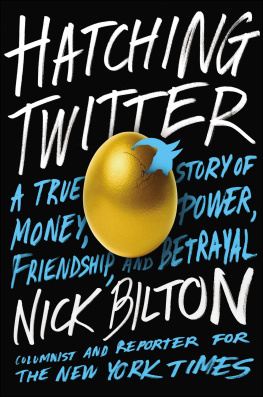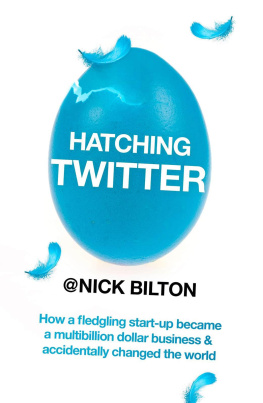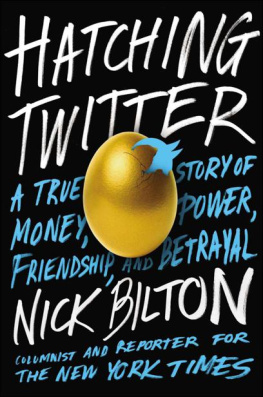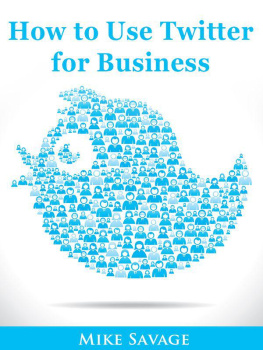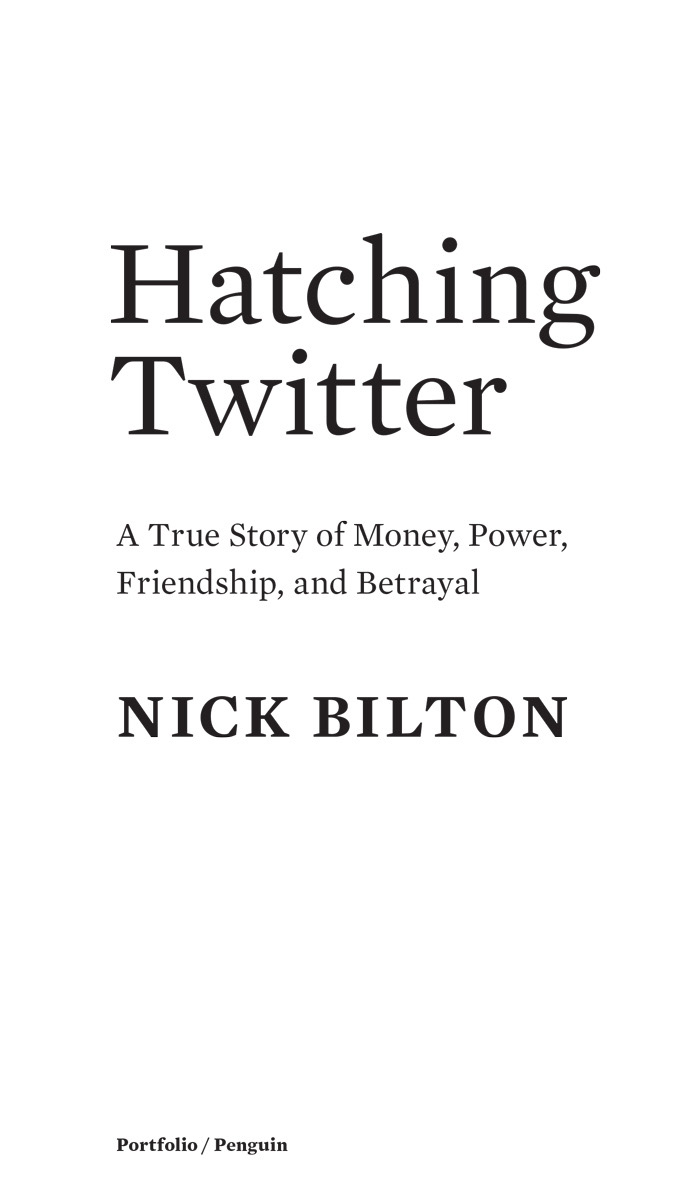Authors Note
T he author Julian Barnes once wrote, History is that certainty produced at the point where the imperfections of memory meet the inadequacies of documentation.
What you are about to read is the result of several hundred hours of interviews with current and former employees of Twitter and Odeo, government officials, Twitter executives friends and significant others, and people at competing companies, as well as discussions with almost everyone mentioned in the book. While Twitter, the company, declined to give me official access for the book, Twitters current and former board members and all four cofounders of the company agreed to sit for, collectively, more than sixty-five hours of interviews. Although most interviews were recorded to ensure accuracy of dialogue, all of these conversations, while on the record to be used within this book, were conducted on background, with the understanding that material would not be explicitly attributed to specific sources within this book. There are only a couple of people mentioned in this book who declined to be interviewed.
It became apparent in the interviews for the book that peoples memories of past events have changed over time. During only a select few occasions two people agreed that a meeting took place, but their recollections of the location or timing were drastically different. In every instance possible I have tried to triangulate timing and location of events using documents I obtained and, of course, social media. There may be some occurrences where this was not possible; in these instances I have done my best to estimate timing. I chose to leave out of this narrative moments of the story for which accounts were too different. In some areas of the book events are referred to a few months earlier than they occur to help the reader understand the overall significance of a moment.
The book is also based on more than a thousand documents I obtained or reviewed during my reporting, including employee e-mails, boardroom presentations, investment filings, contracts, employee calendars, partnership documents, government-level communications, instant-messenger correspondence, newspaper articles, blog posts, and highly confidential Twitter legal notices and internal e-mails. In moments of the book where scenes are described in exact detail, I have often personally visited the location. Any instance of a characters inner monologue or emotional state is based on interviews with that individual and not assumed.
Even with the hundreds of hours of interviews and the internal documents, the most exact location of memory I found was strewn about the Internet on social-media Web sites. With a researcher, I pored through tens of thousands of tweets, photos, and videos.
It became clear in the reporting of this book that the imperfections of memory of those I spoke with have sometimes become more pronounced over the past decade. But what has remained intact are the hundreds of thousands of photos, videos, and tweets they all shared over the years, helping to pinpoint exact moments in time, clothing, conversation, and mood. Unbeknownst to the people in the book at the time, their use of the tools they created, especially Twitter, ensured there were very few inadequacies of documentation to deteriorate the true events that make up this history.
Contents
#START
October 4, 2010, 10:43 A.M.
The Twitter Office
G et out, Evan Williams said to the woman standing in his office doorway. Im going to throw up.
She stepped backward, pulling the door closed, a metal clicking sound reverberating through the room as he grabbed the black wastebasket in the corner of his office, his hands now shaking and clammy.
This was it. His last act as the CEO of Twitter would be throwing up into a garbage can.
He knelt there for a moment, his dark jeans resting on the rough carpeted floor, then leaned back against the wall. Outside, the cold October air rustled the trees that lined Folsom Street below. Violin-like noises of traffic mingled with a muffled din of conversation near his office doorway.
Moments later, someone informed his wife, Sara, who also worked at Twitter, Something is wrong with Ev. She rushed up to his corner office, her rich, black, curly hair wobbling slightly as she walked.
Sara checked her watch, realizing that Ev had only forty-five minutes before he would have to address the three hundred Twitter employees and break the news. She opened the door and went inside.
Down the hall, the Twitter public-relations team reviewed the blog post that would go up on the Web site at 11:40 A.M ., the moment Ev would finish addressing the company and hand the microphone to the new CEO, passing power in a gesture as simple as handing off the baton in a relay race.
The blog post, which would be picked up by thousands of press outlets and blogs from around the world, gleefully announced that Twitter, the four-year-old social network, now had 165 million registered people on the service who sent an astounding 90 million tweets each day. Five paragraphs down, it noted that Evan Williams, the current CEO, was stepping down of his own volition.
I have decided to ask our COO, Dick Costolo, to become Twitters CEO, said the post, allegedly written by Ev.
Of course, that wasnt true.
Ev, seated on the floor of his office with his hands wrapped around a garbage can, had absolutely no desire to say that. A farmers son from Nebraska who had arrived in San Francisco a decade earlier with nothing more than a couple of bags of cheap, raggedy, oversized clothes and tens of thousands of dollars in credit-card debt, Ev wanted to remain chief of the company he had cofounded. But that wasnt going to happen. It didnt matter that he was now worth more than a billion dollars or that he had poured his life into Twitter. He didnt have a choice: He had been forced out of the company in a malicious, bloody boardroom coup carried out by the people he had hired, some of whom had once been his closest friends, and by some of the investors who had financed the company.
Ev looked up as he heard Sara come in. He wiped the sleeve of his sweater across the dark stubble on his chin.

